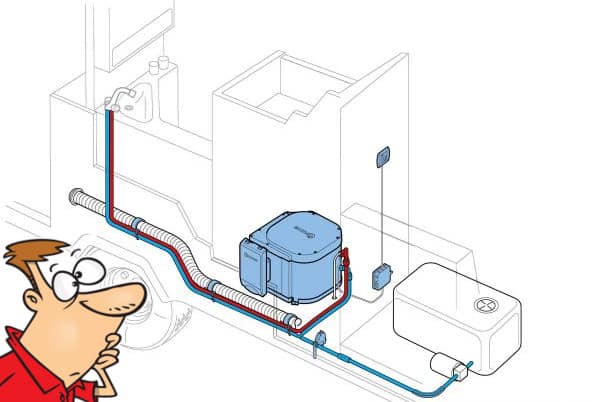
When you’re getting ready for your holiday, your mind is probably on making sure you have packed all the essentials into your motorhome. However, something every motorhome owner should pay attention to is the proper maintenance and cleaning of their water system. Without proper cleaning, a motorhome water system may produce water with a nasty taste or, more seriously, could be contaminated with bacteria. However, using certain water sterilisation products can actually damage the water system in your motorhome. Most motorhomes have onboard water systems. Therefore within this post, I’ll also discuss how these onboard systems can be used most effectively.

If you have read any of my previous posts you’ll know I like to add in a video or two which can add value. And this post on motorhome water systems is no different.
The first video I want to reference is from Practical Motorhome, which discusses quite a few topics around motorhome water storage and use from a safety perspective.
While this video may be more for motorhome beginners, their conversation around water filters is something even experienced motorhome owners may not be aware of.
Disclaimer: Hey! By the way… any links on this page that lead to products on Amazon or Caravan Guard are affiliate links, and I earn a commission if you make a purchase, with no additional cost to you 🙂
- Dissolves waste and removes odours naturally and has delightful mild fragrance
Want To Visit Horton Common? – Book Here
Table of Contents
Filling Up & Emptying A Motorhome Water System
As discussed in the video above, you don’t really want to be using a standard garden hose pipe to fill up the water system in your motorhome. Not only is it not particularly hygienic, but it could also alter the taste of the water.
Really you want to source some food grade hose pipe to fill up your onboard water tank. Now, many of our guests don’t actually drink the water that comes through their motorhomes taps.
Its the reason why on our fully serviced pitches, I put in two taps. One for a portable water connection and one to fill up portable drinking water containers.

Many of our motorhome guests have a portable water container such as this with a tap on the bottom for drinking water: Image – Amazon.co.uk
Getting Water Into The Onboard Tank
Now, while motorhome guests on our site have access to their own dedicated water supply, that’s not the case on all sites.
Therefore, how do you get water into the onboard tank when the tap is not within reach of a hose?
Well, you could use a watering can. However, that could tank a significant around of time and effort. Furthermore, using a watering can is not very hygienic.
You could also use an Aquaroll water container to transport about 40L of water to your motorhome. But how do you then get the water from the Aquaroll container into your onboard tank?
The solution is a 12V submersible pump. Many motorhomes already have a 12V power connection for a portable water pump.
However, even if your motorhome is not currently fitted with an external 12V connection for the pump, its pretty simple to have one fitted.

The Whale Superfil is the most common 12V motorhome submersible water pump for motorhomes to take water from a container into the onboard water tank: Image – Amazon.co.uk
Motorhomes & External Water Containers
As motorhomes often have onboard freshwater and wastewater systems, this provides a different user experience compared to caravans which are typically limited to the sole use of external water containers.
However, some motorhome owners still use external freshwater and wastewater containers.
For instance, if you are staying on a site, but you are also going out on frequent day trips. Well, emptying out your freshwater and wastewater tanks each time you leave the site would be frustrating.
You may think, why bother emptying out the water tanks before you set off? Well, you don’t want to be driving around with significant amounts of water in your motorhome for a couple of reasons.
- Too much water in your freshwater/wastewater tanks may mean you’re carrying more weight than the legal payload for the motorhome.
- Water is heavy, 1L is 1KG, therefore, carrying water around when its not required is ‘dead weight’ which is reducing your MPG.
- Water sloshing around in the tanks can impact the stability of the motorhome and result in poor handling performance.
However, if you are on a short trip taking external water containers (Aquaroll/Wastemaster) with you may be unnecessary and take up valuable storage space within the motorhome.
As referenced above, you really need to understand your motorhome weight plate to know your payload and how much water you can legally carry.
The point is, you need to put some thought into how you are going to use your motorhome water system before setting off on your trip.
While this post is to emphasize the safe use and maintenance of freshwater tanks/containers, wastewater containers can get pretty gross.
Hence, if you have one, you may also want to read my post on how to clean a wastemaster.
How To Clean A Motorhome Water System
As the video above references, while its important to clean your motorhome water system, its also important you only use certain products to do so.
If you boil water in your kettle before consumption, that does sterilise it, but that’s a waste of energy/time in some cases. It also doesn’t apply when washing the dishes, for instance.
Milton, while commonly seen by many as a means to sterilise water containers, its actually corrosive to stainless steel.
Inside your motorhome water system, especially in the boiler, you will find lots of stainless steel.
I’ve previously written a post on how to sterilise a water system and the use of more appropriate products such as Puriclean.
However, I’ve also come across another video from Practical Motorhome and ‘Diamond Dave’ where he talks about the use of citric or acetic acid.
Is It Safe To Use Citric Or Acetic Acid To Clean Your Motorhomes Water System?
Within the video above, Dave discusses the use of citric or acetic acid for cleaning a motorhome’s water system and that they are ‘not harmful to us’.
However, that’s not strictly true. An example of low-concentrated citric acid is lemon juice, and an example of low-concentrated acetic acid is vinegar.
Now, obviously, these two examples are not ‘harmful to us’, but they are very low concentration. How effectively these low-concentration examples would clean a motorhome water system, I’m not sure.
However, you can purchase, for instance, 99% acetic acid. For context, vinegar is 4% acetic acid.
I actually use pure acetic acid to make up my own natural weed killer for the road and pitches on Horton Common. Well, pure acetic acid is hazardous and can seriously burn the skin and eyes.
From personal experience of handling the acid, I wear long gauntlet rubber gloves, a mask and eye protection. You wouldn’t use pure acetic acid as a water system cleaner, you would dilute it down.
And while I produce a 4:1 dilution as a weed killer, I would think that’s still overly strong to clean/sterilise a water system.
However, due to how dangerous it is to handle acetic acid, its not something I feel comfortable recommending to others to use.
Therefore, my personal recommendation to clean a motorhome’s water system is still Puriclean.

A safe but effective means to clean a motorhomes water system is to use Puriclean: Image – Amazon.co.uk
If you want to know more about the process of how to use Puriclean, this post can help.
With a motorhome and onboard water storage tank is not a bad idea to add the Puriclean to the system and drive around for a while.
The acceleration, braking and cornering will help to move the sterilising solution around the inside of the tank. However, you may also want to remove the tank, if possible, for a physical clean.
Physically Cleaning Inside The Motorhome Onboard Water Tank
In the video above, Dave also shows physically cleaning inside of the onboard water tank. He actually removed the tank for the demonstration.
How practical removing the tank is going to be in your scenario is obviously going to depend on the location of the tank on your motorhome, access to it and your physical abilities.
The reason why it can be advantageous to clean inside the tank with a scouring pad and cloth is biofilm.
While mains water contains a small amount of chlorine to stop biofilm build-up, it breaks down after a day or so. Therefore, over time on the inside of the tank, a slimy residue may form, that’s biofilm.
Biofilm can become a breeding ground for bacteria, but it can also cause other problems if it gets dislodged. It can then start to block up the water pump.
It could even be a potential cause of your tap not working. So if it is possible for you to get access to the onboard water tank to clean inside, its worth doing.
How To Clean The Motorhome OnBoard Wastewater Tank
Over time the onboard waste tank on the motorhome may start to smell. You may be at the kitchen/bathroom sink or maybe in the shower and notice a nasty smell coming up from the drain.
With the waste tank, grease and sugar deposits which have gone down the drain pipes start to coat the side of the tank.
This provides an environment for bacteria to breed. The more bacteria which grows in the tank, the worse the smell.
While you could use Puriclean to clean the waste tank, its an expensive means to do so. Also, Puriclean does not have any fragrance of its own to counter any bad smells coming from the onboard waste tank.
Therefore, a more affordable and practical solution in many cases is to use a product such as Thetford’s Tank Freshener.

If you are noticing nasty smells coming up through your motorhome drains it might be worth using some Tank Freshener to clean the onboard wastewater tank: Image – Amazon.co.uk
Conclusions On Motorhome Water Systems & Their Safe Use
In terms of how often you should clean and sterilise the water system, at least once a year at the start of the camping season is pretty typical.
However, ideally, if there are several weeks/months between each time you use your motorhome, you would run through a solution of Puriclean before each trip.
While you may choose to use acetic or citric acid, I would encourage extreme caution, as in high concentrations, they are hazardous.
Finally, try and source some used food-grade pipe to fill up the onboard water tank. Anyways, thanks for reading. I hope you found this post useful.
I’ve now got quite a significant number of motorhome-related posts, so feel free to use the search function at the top of the page to find them or just browse my posts page.
I also hope, at some point in the near future, you will consider coming to visit us here at Horton Common. 🙂
Want To Visit Horton Common? – Book Here


